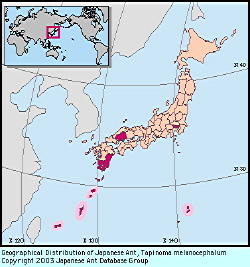
|
species
|
Tapinoma melanocephalum
|
 |
Japanese Name
|
Awate-konuka-ari
|
Original Reference
|
|
Fabricius, J.C. (1793) Entomologia Systematica emendata et aucta. Secundum classes, ordines, genera, species adjectis synonimis, locis, observationibus, descriptionibus 2: 519 pp. Hafniae.
|
Synonym
|
|
Formica melanocephalum Fabricius, 1793,
Myrmica pellucida Smith, F. 1857,
Formica familiaris Smith, F. 1860,
Tapinoma melanocephalum (Fabricius): Mayr, 1862,
Tapinoma melanocephalum var. australis Santschi 1928,
Tapinoma melanocephalum var. australe Santschi 1928,
|
Description
|
|
Total length of workers about 1.5 mm. Body bicolored: antennal funiculus, sides of pro- and mesonota, propodeum, and gaster (with some variation) brown; other parts pale yellow. Antennal scapes long, surpassing the posterior border of head. First segment of antennal funiculus longer than second and third segments together. Eyes large, each with 9 or 10 facets spanning its long axis. Anterior margin of clypeus slightly concave in the middle. No erect setae on mesosoma.
|
Remarks
|
|
This prominent tramp species is widely distributed in the tropical and subtropical zones of the world. There is some doubt that the Japanese species is correctly identified as T. melanocephalum. Nests are found in the soil, under stones, fallen trees, tree bark and in other crevices. The workers move rapidly. T. melanocephalum is a house pest in the tropics (Harada, 1990). Early Japanese collection records are from the botanical gardens at Tennouji, Osaka Prefecture and Takarazuka, Hyogo Prefecture.
|
|

Distribution
|
|
Kyushu, Yaku I., Nansei Is (common), Ogasawara Is., Volcano Is; Taiwan, Hawaii, pantropical.
|
|
References
|
|
- Entomologia Systematica emendata et aucta. Secundum classes, ordines, genera, species adjectis synonimis, locis, observationibus, descriptionibus 2: 519 pp. Hafniae.
- Myrmecologische Studien. Verhandlungen der k. k. ZoologischBotanischen Gesellschaft in Wien 12: 649-776.
- Harada, A. Y. (1990). Ant pests of the Tapinomini tribe. . In R. K. Vander Meer, K. Jaffe & A. Cedeno eds., Applied Myrmecology: A World Perspective. , 298-315. .
- Catalogue of the hymenopterous insects collected at Sarawak, Borneo; Mount Ophir, Malacca; and at Singapore, by A.R. Wallace. Journal of the Proceedings of the Linnean Society of London, Zoology 2: 42-88.
- Smith, F. 1860. Catalogue of hymenopterous insects collected by Mr. A. R. Wallace in the islands of Bachian, Kaisaa, Amboyna, Gilolo, and at Dory in New Guinea. J. Proc. Linn. Soc. Lond. Zool., 5(17b)(suppl. to vol. 4): 93-143.
- Santschi, F. 1928. Hymenoptera, Formicidae. In Insects of Samoa and Other samoan Terrestrial Arthropoda 5. 41-58. London.
|
Editor
|
|
Original text by Keiichi Onoyama and Mamoru Terayama. Revised by Masashi Yoshimura. English translation by Keiichi Onoyama, edited by Robert W. Taylor.
|
|